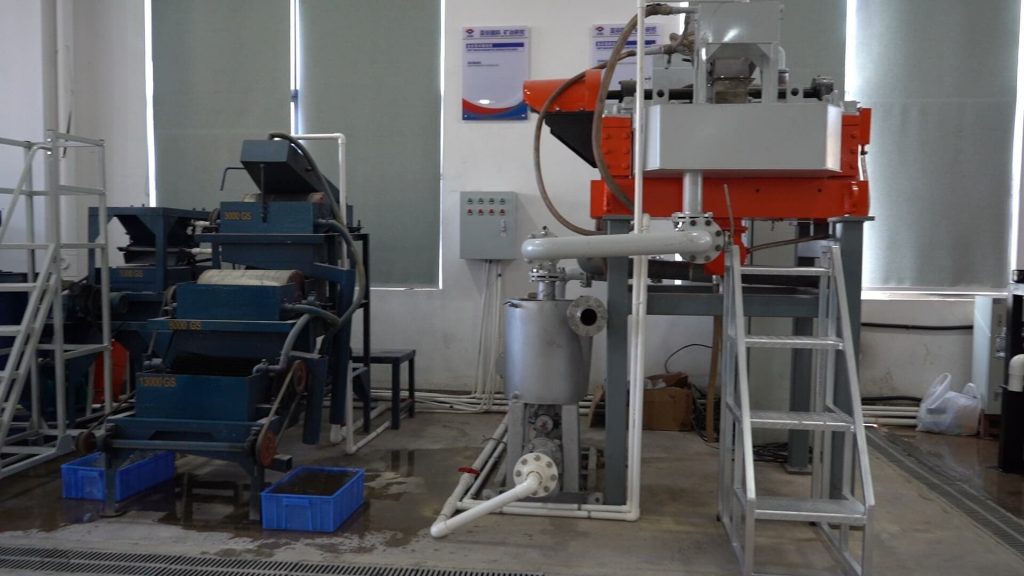Kaolin is a common aluminosilicate mineral that has a white, powdery appearance. It is widely used in ceramics, paper, coatings, rubber, plastics and other industries. It must first be thoroughly tested to understand its properties to unlock its full potential, enabling a purification process to achieve its desired quality and performance. In a laboratory setting, a critical step in this process is selecting the appropriate magnetic separator to remove impurities from kaolin while retaining its desired properties effectively. However, choosing the right one can take a lot of work with the plethora of magnetic separators on the market today. When selecting a magnetic separator, several factors must be considered, such as the kaolin ore’s particle size distribution, impurities’ magnetic susceptibility, and the desired throughput. We will choose the most suitable lab kaolin magnetic separator for you, which can effectively remove impurities such as iron oxide and titanium dioxide from the kaolin granules, thereby enhancing its value and marketability.
How to choose lab kaolin magnetic separator?
The following factors need to be considered when choosing a laboratory kaolin magnetic separator:
- Processing scale and sample size: Consider the laboratory magnetic separator’s processing scale and sample size. If you need to process a large number of samples, you may need a larger scale equipment, and if you are only experimenting with small samples, you can choose small equipment.
- Magnetic impurity content: The magnetic impurity content in kaolin will affect the magnetic separation effect. If the magnetic impurity content is high, choosing equipment with stronger magnetic force may be necessary.
- Magnetic separation effect: Different magnetic separators may have differences in separation effect and magnetic separation efficiency. Some devices may have better separation and more complete removal of magnetic impurities, but may require longer processing times.
- Equipment Operation and Maintenance: In a laboratory environment, equipment operation and maintenance is also an important consideration. Choose equipment that is easy to operate and maintain to ensure smooth experimentation.
- Budget: The price of the equipment is also an essential factor. The cost of magnetic separators of different brands and models will vary, so choose the appropriate equipment according to your budget.
- Manufacturer reputation and technical support: Choose a manufacturer with a good reputation; they usually provide better after-sales support and technical services to get timely help when you encounter problems during use.
When choosing a laboratory kaolin magnetic separator, first clarify your experimental needs, budget and sample characteristics, and then consult Asia-Africa International to make the most sensible choice.
Types of kaolin magnetic separator
The choice of this laboratory kaolin magnetic separation equipment depends on your laboratory needs, sample properties and processing capabilities. Before choosing, it is best to consult the magnetic separation equipment supplier or experts in related fields to determine the most suitable equipment type and specification for your research. The typical kaolin magnetic separators in the laboratory mainly have the following types:
1. Magnetic Plate Separation: This is a simpler type of laboratory magnetic separation equipment, usually used for processing small samples. It consists of a flat plate covered with magnetic material, and the magnetic impurities in kaolin can be separated by adjusting the magnetic field’s strength and the angle of inclination.
2. Drum Magnetic Separator: The magnetic separation drum is a common magnetic separation equipment used to process large batches of samples. It consists of a rotating drum with magnetic material inside. When the sample is rotated in the drum, it is affected by the magnetic field, and the magnetic impurities will be adsorbed on the surface of the drum and separated.
3. Magnetic tube separator: It is a small laboratory magnetic separation equipment used for magnetic mineral separation of small batch samples. It is a closed pipe with a tube of magnetic material inside. When the sample passes through the pipe, it is subjected to the action of a magnetic field to separate the magnetic impurities.
4. High Gradient Magnetic Separator: High Gradient Magnetic Separator is a device with a strong magnetic field gradient, which can effectively separate fine particles of magnetic minerals. It generates a high-intensity magnetic field gradient during the magnetic separation, thereby effectively separating tiny magnetic particles. It is mainly suitable for laboratory magnetic separation research requiring higher separation effects.
Different kaolin magnetic separators may differ in terms of magnetic field strength, processing capacity, and separation effects. It is recommended to consult us (professional equipment supplier) for more detailed advice and guidance.

You can efficiently separate and analyze magnetic impurities in kaolin samples by choosing a suitable type and strength of magnetic separator. This ensures accurate results and reliable data for further analysis and research. In addition, when selecting a magnetic separator, understand the specific requirements of your test and consider factors such as sample size, flow rate, and desired separation efficiency level. In mineral processing, the separation and purification of kaolin is crucial for various industries. So, consult us if you need the best magnetic separator for your laboratory kaolin testing.
